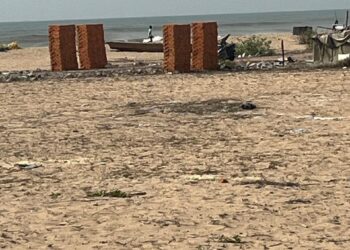By R.Swathi
It poured and poured in Chennai on Dec.4 as Cyclone Michaung scraped past the city. And it left a trail of destruction along the way. Many areas of the city, especially ECR and OMR, saw rampant flooding, with some areas submerged under 6 ft of water. But what was surprising was to find the areas of Besant Nagar, Sastri Nagar and Dr.Radhakrishna Nagar also underwater.

Adyar Times spoke with some residents and experts on the issue to understand why despite having sandy soil, the areas were flooded. Dr.Sekhar Raghavan, Founder of Rain Centre and a resident of Kalakshetra Colony explains that when flooding happens, there are multiple points that a resident must understand:
- Give time for the water to seep in. It takes time for water to percolate inside. And given the increased concretisation, the time taken will be more than usual
- Rise in the water table – waterlogging / flooding is also an indication of the rise in groundwater levels; which is a good sign. If we put our efforts into removing this water, maintaining a good water table during the summers would be an issue. “Over the years, thanks to the many rainwater harvesting systems (RWH) in the area, I have seen a steady rise in the water table,” Dr Raghavan said.
- Concretisation of roads – Ideally, all streets must have a strip of soil on its sides, for water to seep in. This will prevent excessive run-offs to other streets and enable the absorption of water then and there. Concretisation also leads to the stagnation of water in low-lying areas from where it takes even more time to seep into the ground.
- Mindless pumping out of water – Many parts of Besant Nagar got inundated post the rains when water from private residences / institutes was pumped out into smaller lanes.
Dr.Raghavan, however vehemently reminds us that despite the water logging, stormwater drains (SWD) are not a solution to flooding. “If we reduce concretisation and increase our patience, neither will there be so much flooding, nor will there be an issue with temporary water-logging.”
Dr.T.D.Babu, Co-Founder of the civic body SPARK, also points out many issues caused by urbanisation, that lead to flooding at Sastri Nagar, which has SWDs.

- Improper laying of roads: The raised levels and improper gradient of L.B Road, 1st Avenue and MG Road have made the inner roads of Sastri Nagar low-lying, thus flooding the vicinity. The recent improper milling and laying of inner roads led to those roads being at a higher gradient than the others that were not laid, thus inundating the streets that were not laid.
- Concretisation of houses: Many newly built houses are now raised by around 5 ft from the original ground level. They are also completely concretised with little or no percolation area. Thus letting off all rain run-offs on the roads, further increases the load on the road.
- Improper RWH system: Improper or no RWH systems in many apartments lead to additional rainwater runoffs on the roads.
- Insufficient carrying capacity of sewage lines: Due to increased commercialisation, the carrying capacity of the sewer lines is insufficient. During floods / rains, when water enters the sewer lines, there is thus a backflow, leading to sewage entering houses.
- Gradient not leading to SWDs: improper gradient of the roads away from the SWD also led to inundation of houses in the streets.
“There has to be a mindful, coordinated and integrated effort between various agencies of the government for course correction. These issues can surely be resolved,” says Dr.Babu.
While these were points highlighted about flooding caused by rainwater, the neighbourhood of Dr Radhakrishna Nagar was inundated for days after the rains as well. Geeta Padmanabha, a member of RMSM (Dr Radhakrishnan Nagar, Marundeeswarar Nagar, Sivakamipuram, Malaviya Avenue), points out that the reason for flooding in her locality, despite having a SWD: (a) Backflow from the low-lying area of Kamaraj Nagar; (b) Improper desilting of the SWDs; (c) No regulation on pumping out of water from residences / private institutes (d) Road gradient of certain areas laid higher than the others.

Geeta highlights that the main contributing factor the areas were waterlogged for nearly a week since the cyclone, was because of unmindful pumping out of water from residences and commercial establishments, onto the already waterlogged streets. “There are residences that have basement parking. How can such low-lying areas be granted to have basement parking? During rains, the whole of the basement gets flooded and that amount of water is let out, on the already strained roads and SWD systems. There needs to be a regulation on it,” she iterates.
As per the Indian Meteorological Department, Chennai’s rainfall did not match up to the deluge in 2015, yet the city fared poorly. A city’s civic issues must also form part of disaster management. Why should one suffer if solutions are in plain sight?











